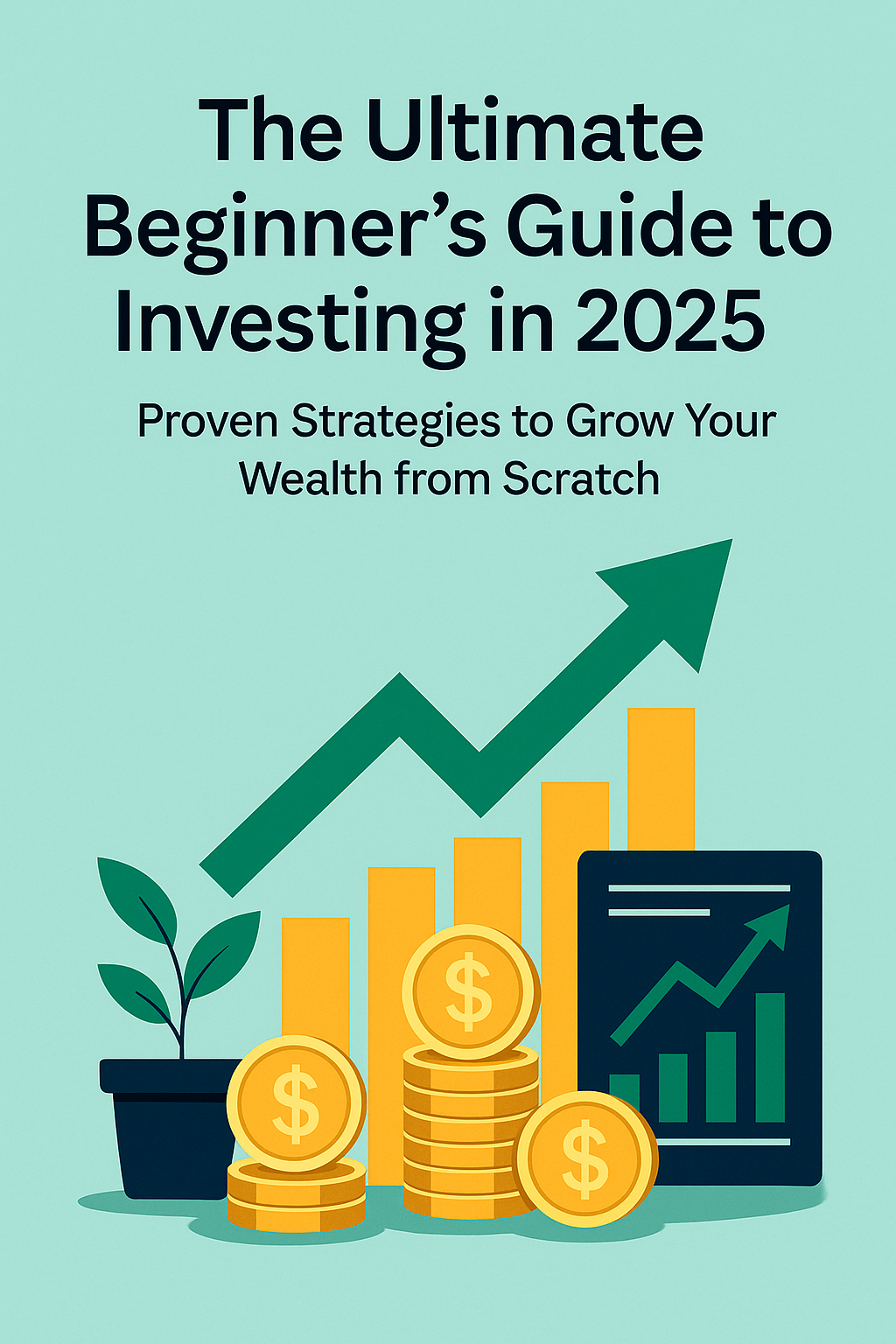
simply amazing, always for you.
Entering the world of investing can feel intimidating at first—like learning a new language or navigating unfamiliar terrain. But here’s the truth: investing isn’t reserved for finance experts or wealthy elites. In 2025, thanks to new technologies and accessible platforms, virtually anyone with a smartphone and a few dollars can begin building wealth through smart investing.

Whether you’re fresh out of college, working your first job, or simply realizing it’s time to make your money work for you, this guide will break down the best investment strategies for beginners. You’ll discover simple, actionable, and realistic ways to grow your wealth steadily and sustainably—even if you’ve never invested a dime before.
Let’s dig into the ultimate 2025 guide to beginner investing, designed to help you build a strong financial foundation that can carry you into a wealthier future.
Table of Contents
- Why You Should Start Investing Now
- Core Principles Every Beginner Should Know
- Getting Started: Tools, Platforms, and Accounts
- Strategy 1: Invest in Broad Market Index Funds
- Strategy 2: Use Robo-Advisors for Automated Growth
- Strategy 3: Embrace Dollar-Cost Averaging (DCA)
- Strategy 4: Take Advantage of Fractional Shares
- Strategy 5: Consider Real Estate Through REITs
- Strategy 6: Contribute to Retirement Accounts
- Strategy 7: Learn to Manage Risk and Diversify
- Strategy 8: Avoid the Most Common Beginner Mistakes
- How to Build Your First Investment Portfolio
- Where to Learn More and Stay Informed
- Build Wealth, One Step at a Time
1. Why You Should Start Investing Now
One of the biggest regrets people report about money is not investing earlier. Here’s why waiting to invest costs you:
- Inflation devalues your savings over time. What $100 could buy in 2010 is not what it buys in 2025.
- Compound interest rewards time in the market. The earlier you start, the more your money grows—without extra effort.
- Financial independence depends on investing, not saving alone. Unless you’re making a seven-figure salary, saving without investing won’t get you there.
Bottom line: the sooner you begin, the better off you’ll be. You don’t need thousands of dollars or a finance degree. You just need to start.
2. Core Principles Every Beginner Should Know
Before diving into specific strategies, let’s look at five foundational principles of investing that never change—even in 2025.
Start Small, Start Now
You don’t need to wait until you have $10,000. Today’s platforms allow you to invest with as little as $1. Starting small gets you into the habit and helps you learn.
Think Long-Term
Real wealth is built over decades, not days. Resist the temptation to chase short-term gains. Patience pays off.
Diversify
Spreading your money across various assets protects you from catastrophic loss. Don’t put all your eggs in one basket.
Automate
Set up automatic monthly investments. You’ll save time, stay disciplined, and build wealth on autopilot.
Educate Yourself
Stay curious. Read, listen, and watch content that helps you grow your understanding. The best investors never stop learning.
3. Getting Started: Tools, Platforms, and Accounts
In 2025, starting your investment journey is easier than ever. You don’t need a broker or a bank appointment. Here’s what you’ll need:
Investment Platforms (Brokerages)
These apps or websites allow you to buy and manage investments:
- Fidelity
- Charles Schwab
- Robinhood
- Public
- SoFi Invest
- M1 Finance
Choose one that fits your style—some are ultra-simple, while others offer advanced tools.
Retirement Accounts
If you’re investing for retirement, consider these accounts:
- 401(k): Employer-sponsored, often comes with a matching contribution.
- Roth IRA: Tax-free withdrawals in retirement.
- Traditional IRA: Tax-deductible contributions.
Taxable Brokerage Account
If you’ve maxed out retirement options or want access to your money before age 59½, use a standard brokerage account.
4. Strategy 1: Invest in Broad Market Index Funds
If you remember nothing else from this article, remember this: broad market index funds are one of the most powerful tools available to new investors.
What Are Index Funds?
They are funds that track a market index, like the S&P 500. When you buy one, you’re essentially buying a tiny piece of hundreds (or thousands) of companies at once.
Why They’re Ideal for Beginners
- Low fees
- High diversification
- Proven long-term returns
Top Index Funds and ETFs for 2025
- Vanguard Total Stock Market ETF (VTI)
- Schwab U.S. Broad Market ETF (SCHB)
- SPDR S&P 500 ETF (SPY)
- Fidelity ZERO Total Market Index Fund (FZROX)
Index funds are boring—but in the best way. They quietly grow your money with minimal risk and minimal drama.
5. Strategy 2: Use Robo-Advisors for Automated Growth
Not everyone wants to pick investments. That’s where robo-advisors come in. These platforms build and manage a portfolio for you, based on your goals and risk tolerance.
Best Robo-Advisors in 2025
- Betterment
- Wealthfront
- Fidelity Go
- SoFi Automated Investing
Why Use One?
- No need to pick individual investments
- Automatically rebalances your portfolio
- Helps you stay invested and diversified
This is a “set it and forget it” option that’s perfect if you want to start immediately without doing a deep dive into finance.
6. Strategy 3: Embrace Dollar-Cost Averaging (DCA)
Dollar-cost averaging is a strategy where you invest a fixed amount at regular intervals—say, $100 every month—regardless of market performance.
Benefits of DCA
- Removes emotion from investing decisions
- Helps avoid buying everything at a market high
- Builds a consistent investing habit
This strategy is especially useful for beginners who might be nervous about market timing.
7. Strategy 4: Take Advantage of Fractional Shares
In the past, you needed full share prices to buy stock. That meant you needed over $3,000 to own one share of certain tech companies. Not anymore.
What Are Fractional Shares?
They allow you to buy a portion of a stock. If Amazon is trading at $3,200, you can invest $10 and own 1/320th of a share.
Platforms That Offer Fractional Shares
- Robinhood
- Fidelity
- Public
- Cash App Investing
- Charles Schwab
This makes it easier to diversify, even with small amounts.
8. Strategy 5: Consider Real Estate Through REITs
Real estate can be lucrative, but most beginners can’t afford to buy a house or manage tenants. REITs (Real Estate Investment Trusts) offer a low-cost alternative.
What Are REITs?
They are companies that own income-producing real estate. You can invest in them like stocks.
Top REITs and REIT ETFs for Beginners
- Vanguard Real Estate ETF (VNQ)
- Schwab U.S. REIT ETF (SCHH)
- Realty Income Corporation (O)
Benefits
- Regular dividends
- Real estate exposure without owning property
- Liquidity—buy and sell like a stock
9. Strategy 6: Contribute to Retirement Accounts
If you’re in your 20s or 30s, retirement might feel like a lifetime away. But what you invest now will multiply many times over by the time you retire.
Start With Your 401(k)
If your employer offers a 401(k), contribute enough to get the full match. It’s free money.
Then Open an IRA
A Roth IRA is ideal if you expect to be in a higher tax bracket later in life. A traditional IRA is good if you want tax deductions now.
2025 Contribution Limits (U.S.)
- 401(k): Up to $23,000
- IRA: Up to $7,000
10. Strategy 7: Learn to Manage Risk and Diversify
Risk is part of investing. The key is not to eliminate it entirely, but to manage it intelligently.
Ways to Reduce Risk
- Diversify across asset classes (stocks, bonds, real estate)
- Invest globally (U.S. and international funds)
- Adjust based on age and goals
For example, a 25-year-old might invest 90% in stocks and 10% in bonds. A 50-year-old might prefer a 60/40 split.
11. Strategy 8: Avoid the Most Common Beginner Mistakes
Even smart beginners fall into traps. Here’s what to avoid:
Chasing Hype
Don’t buy a stock just because it’s trending. By the time it hits the news, the big gains are often gone.
Trying to Time the Market
Even professionals can’t do this consistently. Focus on time in the market, not timing the market.
Ignoring Fees
High-fee mutual funds and advisors can drain your gains. Look for low-cost index funds and transparent platforms.
Overreacting to Volatility
Markets go up and down. Don’t panic sell when things dip. Stay the course.
12. How to Build Your First Investment Portfolio
Let’s put it all together. Here’s how a beginner could start with $1,000:
- 50% in a total stock market ETF (like VTI)
- 20% in an international stock ETF (like VXUS)
- 20% in a bond ETF (like BND)
- 10% in a REIT ETF (like VNQ)
You can easily create this portfolio on most platforms. As you grow, continue contributing and rebalancing once a year.
13. Where to Learn More and Stay Informed
Ongoing education is key to long-term investing success. Here are excellent beginner-friendly resources:
Books
- The Simple Path to Wealth by JL Collins
- I Will Teach You to Be Rich by Ramit Sethi
- Your Money or Your Life by Vicki Robin
Podcasts
- BiggerPockets Money
- The Money Guy Show
- The Investopedia Express
YouTube Channels
- Graham Stephan
- Andrei Jikh
- Nate O’Brien
Consuming one or two pieces of content a week keeps you sharp and confident.
Build Wealth, One Step at a Time
The world of investing is no longer a gated club for the rich or finance-savvy. In 2025, the tools are in your hands. You don’t need to predict the next big stock or time the market perfectly. You just need a plan, discipline, and the courage to get started.
Start small. Stay consistent. Keep learning. The wealth you want tomorrow is built on the choices you make today.

Support Our Website!
We appreciate your visit and hope you find our content valuable. If you’d like to support us further, please consider contributing through the TILL NUMBER: 9549825. Your support helps us keep delivering great content!
If you’d like to support Nabado from outside Kenya, we invite you to send your contributions through trusted third-party services such as Remitly, SendWave, or WorldRemit. These platforms are reliable and convenient for international money transfers.
Please use the following details when sending your support:
Phone Number: +254701838999
Recipient Name: Peterson Getuma Okemwa
We sincerely appreciate your generosity and support. Thank you for being part of this journey!
